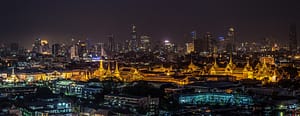Grand Palace
If you only visit one major historical tourist attraction in Bangkok, this should be the one. The royal compound lives up to its name, with spectacular structures that would put the most decadent modern monarchs to shame. It’s also the home of Wat Phra Kaeo, which houses the Jade (or Emerald) Buddha.
Built in 1782, the grand palace was the royal residence for generations and is still used for important ceremonies and accommodating heads of state. Dress modestly when visiting the Grand Palace, which basically means covering your arms and legs and avoiding any sloppy attire.
Wat Pho
Located immediately south of the Grand Palace precinct, Wat Pho makes an excellent addition to your tour, provided your feet are up for more walking. Also known as or Wat Chetuphon), the temple was built by King Rama I and is the oldest and in Bangkok. It has long been considered a place of healing, and was famous centuries ago for its pharmacy and as Thailand’s first “university,” both established by King Rama III. You can get a Thai or foot massage at the traditional medical school on the premises, but the prices are significantly higher than what you will find at massage parlors elsewhere in the city.
Wat Arun
Wat Arun is something of a triumphant complex, dating back to ancient battles between the former Siam and Burma. Having fallen to the Burmese, Ayutthaya was reduced to rubble and ashes. But General Taksin and the remaining survivors vowed to march “until the sun rose again” and to build a temple there. Wat Arun, the Temple of the Dawn, was that temple. It is where the new king later built his royal palace and a private chapel.
Wat Traimit, Temple of the Golden Buddha
During the 1950s, the East Asiatic Company purchased the land around the temple. A condition of the sale was the removal of a plaster statue of Buddha, but the statue proved too heavy for the crane being used. The cable parted and the figure was dropped, being left overnight where it fell. It happened to be in the rainy season, and when next morning some monks walked past, they noticed a glint of gold shining through the plaster. The coating was removed, revealing a 3.5 m Buddha cast from 5.5 tons of solid gold.
All attempts to trace the origin of this priceless statue have so far failed, but it is assumed to date from the Sukhothai period, when marauding invaders threatened the country and its treasures, and it became common practice to conceal valuable Buddha figures beneath a coating of plaster. No one knows how it came to Bangkok, but here it stands available for the admiration of visitors from all over the world.
Wat Suthat
Wat Suthat, adjacent to the Great Swing, is one of the oldest and most beautiful of Bangkok’s Buddhist temples. Three kings had a hand in its construction: it was begun soon after the coronation of Rama I (founder of the Chakri dynasty) in 1782, continued by Rama II, and completed ten years later by Rama III. Apart from its delightful architecture, the temple boasts some exceptionally interesting wall paintings. Wat Suthat is less popular than some of the other temple complexes in the city, so you’ll enjoy a more peaceful and intimate experience here.
Giant Swing
In the center of the busy square in front of Wat Suthat stands one of Bangkok’s most eye-catching sights, the 27 m high teak frame of the so-called Giant Swing. This used to be the focus of a religious ceremony held every year in December after the rice harvest. Teams of three took turns to balance on a dangerously narrow board and be swung 25 m or more off the ground “up to Heaven”, at which point they would attempt to catch a bag of silver coins in their teeth. King Rama VII banned the contest in 1932, following a number of fatal accidents.
Khao San Road
This is Bangkok’s infamous backpacker district, a neighborhood jam-packed with guesthouses, food vendors, clothing stalls, and travelers from every corner of the globe. You’ll need to tap into your patience when hanging out here because, while it is colorful and exciting in its own way, the crowds and scents and blaring music can test even the calmest soul. But it is a great place to pick up a few pairs of the baggy fisherman pants – the perennial staple of every backpacker’s wardrobe when trekking through Thailand, browse the treasures in a used bookstore, and dig into some delicious Indian food from a neighborhood restaurant.
Jim Thompson House
The historic home of a “self-made American entrepreneur” who disappeared while traveling in Malaysia now stands as a relic of an older time in Bangkok. Jim Thompson settled in Thailand after spending time there as a serviceman around the end of WWII. He was a prominent figure in the Thai silk industry and was awarded the Order of the White Elephant, a significant honor given to foreigners who have made contributions to Thailand. Thompson’s home has been turned into a museum offering insights into his life and business, as well as the history of the city and the Thai silk industry.
Terminal 21
The name might lead you to think this is a transport hub, but it’s actually a shopping mall. And you might be wondering why you would want to visit a shopping mall for kick while traveling. Well, Terminal 21 has a special flair – even by Thailand’s shopping standards. Every floor of the mall has been themed to a different international city. Enter at the level of the BTS station and you’ll be in Paris; go up a floor and its Tokyo; another floor and you’re staring at the iconic red phone booths of London. The Caribbean, San Francisco, and Istanbul also figure into the design theme.

